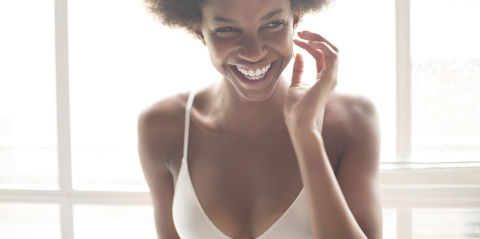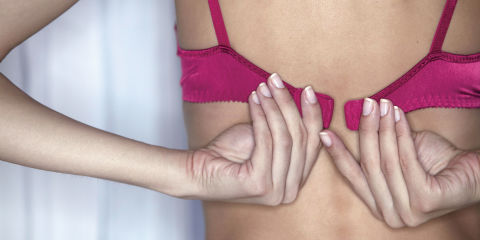Your breasts can be a barometer for wellness. So you should know how to read them.
Your breasts can
communicate a lot about what’s going on inside your body and it’s
healthy practice to get familiar with what your breasts look and feel
like – but remember that there’s no right or wrong way to check your
boobs.
Before reading on, remind yourself that most breast changes will not be cancer. However,
if you notice a change and are concerned (even if you’re not feeling
unwell) head to a GP to get everything checked out.
Use these signs to learn what your breasts are telling you…
Your breasts are growing
1. It could mean you’re gaining weight.
After puberty, your breasts grow when the rest of you gets bigger.
Weight gain could happen for any number of reasons: You could be eating
more, moving less, skimping on sleep, or super-stressed. While a couple
of pounds here and there are usually no big deal, an excessive increase
in body fat can up your risk of developing various cancers, according to
The National Cancer Institute.
2. It could mean you’re getting your period, you just started a new birth control, or you’re pregnant. Hormonal
changes can trigger a breast tissue growth spurt, explains Mary Jane
Minkin, M.D., an ob-gyn and clinical professor at the Yale University
School of Medicine. As long as both breasts are doing the same thing,
it’s probably no reason for concern.
Your breasts are shrinking
1. It could mean you’re losing weight. Because
your breasts are made up of fatty tissues, breast bulk can be the first
thing to go when your weight loss efforts start to work. If you’re
effortlessly shedding pounds and cup sizes, and you can’t figure out
why, see your doctor to rule out the scary stuff, like an overactive
thyroid or a chronic disease.
2. It could mean your cycle is starting. What
goes up (your cup size) must come down — so if your breasts swell
leading up to the first day of your period, they’ll shrink once your
period starts and your hormones relax.
One breast is bigger than the other
1. It’s probably not an issue. No one’s breasts are perfectly symmetrical — and different-shaped breasts are fine and normal, Dr. Minkin says.
2. Or, it could be a sign of breast cancer. When
one breast changes shape significantly, it could signal an abnormality
linked to breast cancer, says Dr. Minkin. Don’t panic — just see your
doctor right away for a formal exam.
You have under-boob irritation
1. You might be allergic to something — like
the underwire in your bra, which may be made of nickel, which is a
common irritant. Or it could be soap residue or an itchy sweater. Treat
your rash with a topical hydrocortisone cream. If it goes away within a
few days, you’re good to go.
2. It could mean you have inframammary intertrigo.
It’s a fancy way of saying the crease between the bottom of your breast
and the skin beneath it is rubbing and causing inflammation — a common
occurrence in the summer. An antibiotic or steroid cream, OTC cortisone,
or Neosporin can reduce inflammation while the right-size bra can keep
your breasts off your chest to separate the skin in the first place.
3. It might mean you need to wash your bra. Wearing
and re-wearing the same bra or sports bra may seem like a good way to
extend its life. But in actuality, it can foster bacterial and fungal
infections — especially if you tend to sweat beneath your breasts.

You have visible stretch marks
1. It could mean you’ve gained and lost weight. Any
time your weight yo-yos, the breasts expand and contract, which can
result in stretch marks on the breasts, says Barry Weintraub, M.D., a
New York City-based cosmetic plastic surgeon and a national spokesperson
for the American Society of Plastic Surgery. This is true particularly
after pregnancy and in women who are born with skin that’s not so
stretchy.
You have particularly dark or light nipples
1. It’s probably not a big deal. “This is not related to breast cancer,” Dr. Weintraub says. “Different women just have different pigmentation patterns.”
Your nipples are very large or small
1. Again, this probably isn’t a cause for concern. Dr. Minkin chalks this up to normal variation.
You have bumps on your areola
1. It’s probably nothing to worry about. The
breast is designed for milk production, and those bumps are just the
ends of milk ducts. They sometimes puff out a bit, so it’s normal to
have small, pimple-like bumps on your areolas.
You have one large bump on your areola
1. You could have a benign cyst or it could be a sign of breast cancer. Calmly
call your GP to schedule a screening as soon as you can. He or she can
tell you whether you’re feeling normal breast tissue or have cause for
concern.
You have more than a few stray hairs
1. It could mean you’ve been exposed to testosterone cream or gel.
Some guys use the stuff to boost sex drive — but rubbing up against
said guy can expose you to the hormone and its side effects, Dr. Minkin
explains. This could include hair growth in random places.
2. You could have polycystic ovarian syndrome (PCOS). If
you find yourself suddenly sprouting chest hair, your testosterone
levels might be elevated due to PCOS, a condition where your ovaries or
adrenal glands produce excessive amounts of male hormones, resulting in
cysts (fluid-filled sacs) on the ovaries, and other symptoms such as
acne and irregular periods. Because PCOS can result in infertility if
left untreated, see your doctor for a formal diagnosis if these symptoms
sound familiar.
Your nipples are itchy
1. It might mean you left shampoo or soap residue on your breast. Just rinse off with water and apply hydrocortisone cream for some sweet relief.
2. Or you’re allergic to your clothing. A
new bra can contain dye or other compounds that elicit a reaction — and
the same goes for a wooly sweater. Apply hydrocortisone cream and
change clothes or bras to see if the itch goes away.
3. Or you’re getting your period. Sometimes changes in your hormones (the ultimate scapegoat!) can trigger itchiness leading up to your period.
4. Or you could have Paget disease. It’s
also known as nipple carcinoma, a very rare form of breast cancer. Look
for itchiness around the nipple and areola; flaky, crusty skin; a
flattened nipple; and yellow or bloody discharge — and see your health
care provider ASAP if any of these symptoms sound familiar.
Your breasts feel lumpy and painful
1. It might mean you’re getting your period. It’s
pretty common to experience changes in your breasts — from the texture
to sensitivity — in the days leading up to your period. And it’s normal
to wonder whether these changes signal something more serious (like a
cancerous tumour)
2. It might mean you’re OD-ing on caffeine. Caffeine
can sometimes aggravate breast soreness — so cutting back on coffee and
sodas (in addition to taking the supplements listed above) can help
bring your breasts back to baseline.
Your nipples leak white, milky discharge
1. It could mean you’re feeling stimulated.
The breasts are designed for milk-making, so a little leakage that
resembles milk just means they’re just doing their thing. It can happen
in response to physical stimulation — and you don’t have to be pregnant
or nursing to experience it, Dr. Minkin explains. If the odd drop
bothers you, there are some medications that can help.
2. It might be because you’re taking an antidepressant or antipsychotic. Some
prescription meds elevate your levels of prolactin, the hormone that
stimulates milk production. The vast majority of the time, this isn’t
dangerous — it’s just a pesky side effect.
Your nipples leak bloody discharge
1. You could have a noncancerous tumour. Also
known as a papilloma (an overgrowth of milk ducts), it warrants a visit
to your health care provider for investigation — especially if you
notice this symptom in only one breast, which isn’t a great sign, Dr.
Weintraub says.
Your nipples are hard
1. It might mean you’re aroused. Nipple
firmness rarely has anything to do with breast tissue abnormality
unless there’s some sort of asymmetry, Dr. Weintraub says. It’s just a
contraction of the small muscles around the nipple and is associated
with stimulation before or after sex.
2. It might mean you’re cold. When sex is the last thing on your mind and your headlights are on, the simplest explanation is that the heat is off.
You have a retracted nipple or a puckering indentation in the nipple or breast
1. It could be a sign of breast cancer.
Any kind of dimpling in the nipple or breast could be a sign of breast
cancer. So if your first impulse is to see a doctor ASAP, you’re right
on the money.
You can see your veins through your skin
1. You may be more susceptible to skin cancer.
Pale, translucent breasts are a predictor of fair skin, which makes you
especially susceptible to sunburn. But as long as you don’t worship the
sun and apply sunscreen liberally to exposed skin, you shouldn’t have
any major problems.
The skin of your breast resemble the skin of an orange
1. It could be a sign of breast cancer. If
your formerly smooth breast starts to feel rough (like an orange peel),
with a hardened areola and nipple it could be a sign of breast cancer,
and you should definitely get it checked out, Dr. Weintraub says.
There’s a bump on one breast
1. You could have a benign cyst.
If it feels round and smooth, and it wiggles, it’s probably a benign,
fluid-filled cyst (not a tumour.) Take the vitamin combo suggested in
no. 21 and wait one cycle to see if it goes away. If it persists, your
doctor can do an ultrasound to check out things.
2. It could be a sign of breast cancer. While
the vast majority of breast pains and masses are a normal result of
fluctuating hormones, “whenever you notice a breast mass, the question
is always: Is this cancer or could it turn into cancer?” Dr. Minkin
says. It’s a question your health care provider is best suited to answer
— so make an appointment to get checked out if you’re concerned.





No comments:
Post a Comment